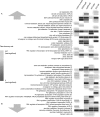Gene regulation in parthenocarpic tomato fruit
- PMID: 19700496
- PMCID: PMC2736898
- DOI: 10.1093/jxb/erp227
Gene regulation in parthenocarpic tomato fruit
Abstract
Parthenocarpy is potentially a desirable trait for many commercially grown fruits if undesirable changes to structure, flavour, or nutrition can be avoided. Parthenocarpic transgenic tomato plants (cv MicroTom) were obtained by the regulation of genes for auxin synthesis (iaaM) or responsiveness (rolB) driven by DefH9 or the INNER NO OUTER (INO) promoter from Arabidopsis thaliana. Fruits at a breaker stage were analysed at a transcriptomic and metabolomic level using microarrays, real-time reverse transcription-polymerase chain reaction (RT-PCR) and a Pegasus III TOF (time of flight) mass spectrometer. Although differences were observed in the shape of fully ripe fruits, no clear correlation could be made between the number of seeds, transgene, and fruit size. Expression of auxin synthesis or responsiveness genes by both of these promoters produced seedless parthenocarpic fruits. Eighty-three percent of the genes measured showed no significant differences in expression due to parthenocarpy. The remaining 17% with significant variation (P <0.05) (1748 genes) were studied by assigning a predicted function (when known) based on BLAST to the TAIR database. Among them several genes belong to cell wall, hormone metabolism and response (auxin in particular), and metabolism of sugars and lipids. Up-regulation of lipid transfer proteins and differential expression of several indole-3-acetic acid (IAA)- and ethylene-associated genes were observed in transgenic parthenocarpic fruits. Despite differences in several fatty acids, amino acids, and other metabolites, the fundamental metabolic profile remains unchanged. This work showed that parthenocarpy with ovule-specific alteration of auxin synthesis or response driven by the INO promoter could be effectively applied where such changes are commercially desirable.
Figures








References
-
- Abad M, Monteiro AA. The use of auxins for the production of greenhouse tomatoes in mild-winter conditions—a review. Scientia Horticulturae. 1989;38:167–192.
-
- Amador V, Monte E, García-Martínez JL, Prat S. Gibberellins signal nuclear import of PHOR1, a photoperiod-responsive protein with homology to Drosophila armadillo. Cell. 2001;106:343–354. - PubMed
-
- Benjamini Y, Hochberg Y. On the adaptive control of the false discovery fate in multiple testing with independent statistics. Journal of Educational and Behavioral Statistics. 2000;25:60–83.
-
- Blein JP, Coutos-Thévenot P, Marion D, Ponchet M. From elicitins to lipid transfer proteins: a new insight in cell signaling involved in plant defence mechanism. Trends in Plant Science. 2002;7:293–296. - PubMed
Publication types
MeSH terms
Substances
Grants and funding
LinkOut - more resources
Full Text Sources
Other Literature Sources
Molecular Biology Databases
Research Materials

